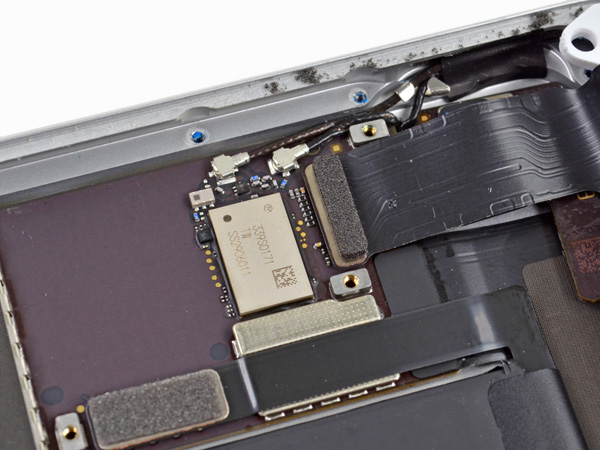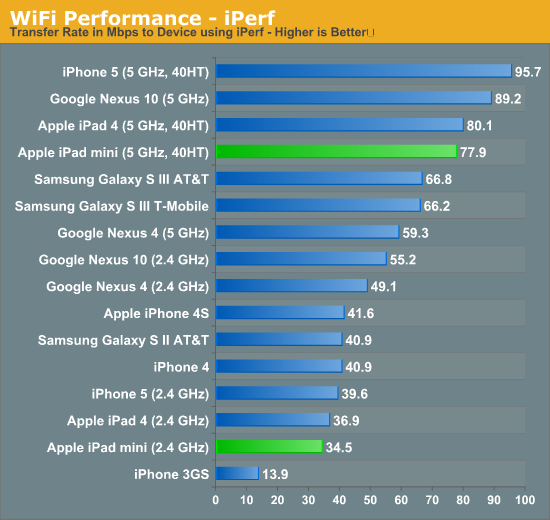iPad mini Review
by Anand Lal Shimpi & Vivek Gowri on November 20, 2012 6:10 PM ESTWiFi Performance
The mini uses the same Broadcom BCM4334 WiFi controller as the iPhone 5. The WiFi stack supports dual-band 802.11n as well as fallback to 802.11b/g.

iPad mini WiFi controller - image courtesy iFixit
Since the mini uses the same WiFi stack as the iPhone 5, you get support for 40MHz channels on 5GHz networks (20MHz on 2.4GHz). The maximum PHY rate supported is 72Mbps on 2.4GHz and a whopping 150Mbps on 5GHz.

In terms of actual performance, this works out to be a maximum of just under 100Mbps on a 5GHz network with 40MHz channels. In practice I wasn't able to get higher than 91Mbps, although Brian managed a very nice 95.7Mbps on the iPhone 5 in his tests. On average I pulled nearly 78Mbps on the mini on a 5GHz network. Move down to 2.4GHz and performance is cut roughly in half (peak performance is around 41Mbps).

I didn't have any issues with WiFi reception or performance in my testing of the iPad mini. The only complaint I really have at this point is I would love to see more intelligence when it comes to switching between multiple known APs of varying signal strengths. This is a problem on pretty much all devices I play with, they tend to want to stay on an existing network even if its performance drops significantly and there is another, better performing network that could be jumped to. I feel like some more intelligence in this department (testing nearby networks, looking for an ability to seamlessly switch and get better performance) would help mitigate a lot of the inevitable "hey my WiFi is broken" complaints we often see with a move to a new WiFi stack. You could also argue that we just need better designed WiFi deployments.










140 Comments
View All Comments
Zink - Wednesday, November 21, 2012 - link
http://www.youtube.com/watch?v=5MMmLQlrBwstwtech - Tuesday, November 20, 2012 - link
I hope Google keeps the same screen size for the next 7" Nexus, but trims into the border a bit on the sides. Right now it's right at the limit for wrapping a hand around it, and I have pretty big hands.Crocography - Tuesday, November 20, 2012 - link
And also its all metal back is too slippery compared to the Nexus 7. I waited for both to be release before I bought the Nexus 7 32Gb. (bought one by selling my iPad 2013 model -- never really used it much)jjj - Tuesday, November 20, 2012 - link
If Apple is Apple they should have made this higher end and price it at 400$, and that still is what Job's Apple would do.Next year with the ipad 2 gone,they would need to drop the ipad 4 to 400$ or retire it so covering the 400$ range with the mini would make more sense.The cost of the SoC is a relative thing,32nm yields will get better by then,keeping it thin could be problematic if they double the res.PS; i am in no way suggesting this would be a price worth paying, just sayiing what would Apple do.
dishayu - Wednesday, November 21, 2012 - link
Is it possible Apple made the iPad mini worse than they were capable of, right now, just so that they can effortlessly update it and make more money out of it?ltcommanderdata - Wednesday, November 21, 2012 - link
Like any product designer, Apple has got to optimize for a variety of factors including component availability, component cost, final sale price, what features customers want, what features customers can tolerate not having, etc. If they just cared about maximizing profits they might as well have just thrown in the A4 from the iPhone 4 and a larger version of the TN panel used in the iPhone 3GS since they share the same dpi anyways.The iPad Mini already has worse battery life than the iPad 2 even without a retina display. Adding a retina display and a faster SoC to drive it will make this even worse unless a larger battery is included. One of the main features of the iPad Mini is how thin and light it is, even thinner and lighter than competing 7" tablets despite having a larger screen. Gaining a retina display in exchange for a thicker, heavier tablet may silence some complaints but will only create new ones. What's worse, a thicker, heavier design might make the iPad Mini difficult to hold given it's thin bezel design with limited grip area, so is a non-starter given current technology in 2012. Hopefully Anand is wrong in his prediction that a Retina iPad Mini isn't possible in 2013 either and that improvements in display tech, battery tech, and a move to the Samsung 28 nm process for the SoC will make it happen.
marcolorenzo - Wednesday, November 21, 2012 - link
Whilst I'm sure it was possible for Apple to include the retina display and the A6 SoC, it's more likely that they chose not to since it would make the device bigger and heavier due to the bigger battery it would require. Apple was simply not willing to make that sacrifice. Next year when the technology is more mature, they will implement it.drx11 - Sunday, November 25, 2012 - link
--------------------------------------------------------------------------RE: On purpose by marcolorenzo on Wednesday, November 21, 2012
Whilst I'm sure it was possible for Apple to include the retina display and the A6 SoC, it's more likely that they chose not to since it would make the device bigger and heavier due to the bigger battery it would require....
--------------------------------------------------------------------------
Exactly - this is the iPad 4 (gen)!
aravenwood - Wednesday, November 21, 2012 - link
Anand,Thanks for the article, but the most interesting thing you mention never gets explored at all in the article. On the first page you say:
"But here’s the thing - I don’t consider the iPad mini a competitor to the Nexus 7. The Nexus 7, to me, is what I buy if I’m in the market for a $199 tablet or I want a 7” Android device. It’s a completely different experience than the iPad mini. In my mind, the closest competitors for the iPad mini are, in order, the iPad 2, the Kindle Fire HD 8.9”, and the Nook Tablet HD+. The iPad 2 is obvious because these are the two lowest priced iOS tablets right now, and with similar underlying hardware, they’re actually pretty closely matched. I think the latter two are especially interesting comparisons to make, because all three exist in the ~$300 “small premium tablet” niche that has suddenly appeared."
You say that the comparison with the Nook HD+ and Kindle are the most interesting comparisons, in a small premium tablet niche, but you never come back to this. Can you elaborate on this, maybe in a followup article? I for one have basically discounted the iPad Mini, and the kindle in favor of the Nook HD+. I haven't bought it yet, but I am leaning heavily - the only drawback is the lack of camera and GPS. The price, quality of screen build quality is compelling. In general I feel that Nook HD/HD+ doesn't get the respect it deserves. I have been holding off because I can't any serious (e.g. Anandtech type) reviews of the device and i want to read some real discussion of it's qualities and get a no-bs assessment of the good and bad and comparison to the Kindle and nexus 10.
So that's my Thanksgiving wish - if you have down time, can we please have a review of the Nook HD +?
Thanks,
Michael
MadMan007 - Wednesday, November 21, 2012 - link
Seconded. The Nooks and Kindles may be some of the more popular tablets among the less tech savvy. They aren't the fastest or most up to date, but they do have nice feature sets, and B&N doesn't overcharge for built-in storage upgrades. The Nook HD+ and Fire HD 8.9" both have very high resolution screens. Maybe the custom software makes them harder to review? I still think it's worth it even if they aren't directly comparable to other tablets for that reason, plus you could explore loading custom ROMs if possible (I didn't bother to look up whether they are hackable)